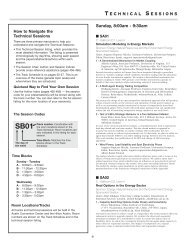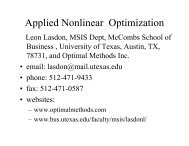[PDF] ALIO Back Matter
[PDF] ALIO Back Matter
[PDF] ALIO Back Matter
You also want an ePaper? Increase the reach of your titles
YUMPU automatically turns print PDFs into web optimized ePapers that Google loves.
SC16<br />
4 - Compensatory Fuzzy Logic: A New Axiomatic Approach for<br />
Fuzzy Logic<br />
Rafael Espin, Professor, Instituto Superior Politécnico José Antonio<br />
Echeverría (CUJAE), CUJAE. Marianao, La Habana, CP 19930, Cuba,<br />
espin@ind.cujae.edu.cu, Eduardo René Fernández González<br />
Compensatory Fuzzy Logic, a new compensatory non associative axiomatic<br />
approach for multivalued logic, is presented. Based Geometric Mean Compensatory<br />
Logic (BGMCL), a multivalued approach from this perspective and some relevant<br />
properties like an a special way of generalization of Boolean Logic, are presented<br />
too.<br />
■ SC16<br />
Aula 385- Third Floor<br />
The Next Ten Years in Metaheuristics Research<br />
Cluster: Metaheuristics<br />
Invited Session<br />
Chair: Natalio Krasnogor, University of Nottingham, United Kingdom,<br />
nxk@Cs.Nott.AC.UK<br />
1 - How Many Good Ideas Do You Need?: An Investigation of Sizing<br />
Effects in Meta-heuristics with Evolving Local Search Operators<br />
Jim Smith, The University of the West of England,<br />
Bristol Institute of Technology, United Kingdom<br />
We investigate the search efficiency of a class of adaptive memetic algorithms where<br />
the local search operators are co-evolved alongside a population of potential<br />
solutions to the problem in hand. Such co-evolutionary mechanism requires a<br />
means for assigning meme fitness based in some way on the improvement they<br />
cause in solutions at a particular stage in the search process. We examine schemes<br />
based on both the extremal and mean improvement caused, and compare these to<br />
the implicit self-adaptive scheme. Simultaneously we examine the effect of using<br />
different fixed or adaptive pivot functions and depths of search. Results show that<br />
provided the fitness is correctly assigned the system successfully adapts the<br />
global/local search trade-off via evolution of the memes’ search depth. The system is<br />
also able to adapt the optimal choice of greedy or steepest ascent. Unlike recent<br />
work on adaptive operator choice, results suggest that a fitness based on a meme’s<br />
mean, rather than extremal affect provides more reliably effective optimisation<br />
results. Despite the close coupling between the two population, the self-adaptive<br />
schemes which use implicit fitness assignment are less successful than a well<br />
designed co-evolutionary scheme. Finally we examine the effect of changing the<br />
size of the meme pool and show that a surprisingly large number can be processed<br />
and benefit evolution.<br />
2 - Hyper-heuristics: Past, Present and Future<br />
Graham Kendall, University of Nottingham, United Kingdom,<br />
graham.kendall@nottingham.ac.uk<br />
Hyper-heuristic research can be traced back to the 1960s, although the term was<br />
only first used in the late 1990s. After outlining the motivation underpinning hyperheuristics,<br />
we will present a brief history of the area and provide an overview of<br />
some of the work that is being undertaken at the present time. Finally, some<br />
potential research directions will be discussed, as well as some of the challenges that<br />
we face.<br />
3 - Automated Parameter Tuning with CMA-ES and Divide-and-evolve:<br />
Lessons Learn and Challenges Ahead<br />
Marc Schoenauer, Université Paris Sud, INRIA Saclay, 15,<br />
rue Georges Clemenceau, Orsay Cedex, 91405, France,<br />
marc.schoenauer@u-psud.fr<br />
Parameter tuning has always be the Achille’s heel of Meta-Heuristics in general, and<br />
Evolutionary Computation in particular. Several approaches will be surveyed in this<br />
talk, from off-line setting to one-line adaptation of the meta-parameters of the<br />
search algorithms. Whereas off-line tuning has now reached a mature state, with<br />
several efficient approaches, on-line adaptation remains out of reach in most<br />
contexts. CMA-ES (Covariance Matrix Adaptation Evolution Strategy) is one<br />
remarquable exception. It will be briefly introduced, and some lessons that can be<br />
learned from its success will be proposed, while some other remaining challenges<br />
will be described.<br />
4 - An Unorthodox View on Memetic Algorithms<br />
Natalio Krasnogor, University of Nottingham, United Kingdom,<br />
nxk@Cs.Nott.AC.UK<br />
Memetic Algorithms have become one of the key methodologies behind solvers that<br />
are capable of tackling very large, real-world, optimisation problems. They are being<br />
actively investigated in research institutions as well as broadly applied in industry.<br />
In this talk we provide a pragmatic guide on the key design issues underpinning<br />
Memetic Algorithms (MA) engineering. We begin with a brief contextual<br />
introduction to Memetic Algorithms and then move on to define a Pattern<br />
Language for MAs. For each pattern, an associated design issue is tackled and<br />
illustrated with examples from the literature. We then fast forward to the future and<br />
mention what, in our mind, are the key challenges that scientistis and practitioner<br />
will need to face if Memetic Algorithms are to remain a relevant technology in the<br />
next 20 years.<br />
<strong>ALIO</strong> / INFORMS International – 2010<br />
40<br />
■ SC17<br />
Aula 387- Third Floor<br />
Data Mining/Machine Learning II<br />
Contributed Session<br />
Chair: Maria Teresinha Arns Steiner, Universidade Federal do Paraná,<br />
UFPR/Centro Politécnico/Jd das Américas, Curitiba, 81.531-990, Brazil,<br />
tere@ufpr.br<br />
1 - Predictive Modeling and Optimization<br />
Steven Shugan, Professor, University of Florida, 2030 NW 24th<br />
Avenue, Gainesville, FL, 32605, United States of America,<br />
sms@ufl.edu<br />
Many decisions depend on selecting the correct response function. Empirical<br />
research sometimes uses predictive accuracy to make selections. However, there are<br />
always wrong response functions that predict better than the true function. The<br />
reason is not faulty estimation, simplicity, or parsimony. Moreover, whether<br />
prediction is vastly better or barely better, wrong response functions dramatically<br />
underestimate optimal expenditures.<br />
2 - Technical Groups and Ranking in The KDD Context – Application to<br />
the Itaipu Instrumentation Data<br />
Maria Teresinha Arns Steiner, Universidade Federal do Paraná,<br />
UFPR/Centro Politécnico/Jd das Américas, Curitiba, 81.531-990,<br />
Brazil, tere@ufpr.br, Rosangela Villwock, Andrea Sell Dyminski<br />
The monitoring of a dam can generate an enormous mass of data which analysis is<br />
not trivial. Itaipu dam has more than 2,200 monitoring instruments. The goal of this<br />
work is to present a methodology to carry out the ranking to the instruments. The<br />
methodology was applied to extensometers. The Ward Method was used in the<br />
clustering and it was possible to find technical justification for the formation of the<br />
groups. The Factorial Analysis showed to be effective to realize the ranking.<br />
■ SC18<br />
Aula 384- Third Floor<br />
Vehicle Routing I<br />
Contributed Session<br />
Chair: Sergio Daniel Conde, Professor, Universidad Argentina John F,<br />
Kennedy, Carlos Crocce 757, Lomas de Zamora, 1832, Argentina,<br />
sergiodanielconde@fibertel.com.ar<br />
1 - An Approach for the IRP Based on Separable Cross Decomposition<br />
and Harmony Search<br />
Mayra Elizondo, PhD, Universidad Nacional Autónoma de México,<br />
Cd. Universitaria Edif. Bernardo Quintan, México D.F., 04510,<br />
Mexico, mayra.elizondo@hotmail.com, Roman Mora<br />
The Inventory-Routing Problem is NP-hard. A three-phase strategy is used to solve<br />
it: Phase 1: Which customers should be visited? Phase 2: What volume of products<br />
should be delivered and what vehicle will be used to supply each customer? And,<br />
Phase 3: Which route should be followed by each truck? The phase 2 uses Cross<br />
Separable Decomposition. The phase 3 consists on many TSP and we use the<br />
metaheuristic, harmony search to solve them. The result is a very efficient ranking<br />
algorithm O(n3).<br />
2 - Covering-routing Problems Considering Sensitive Areas<br />
Maria José P. Lamosa, IEAv/CTA, Rod. dos Tamoios, km 5,5 - Putim,<br />
São José dos Campos, 12228-001, Brazil, maju@ieav.cta.br,<br />
Mónica Maria De Marchi, Daniel Merli Lamosa<br />
This work aims to solve a routing problem in order to cover a region where certain<br />
areas are considered sensitive and must therefore be revisited in the shortest time<br />
possible. In this case, the objective is to find an efficient route that minimize the<br />
maximum time that these areas remain uncovered. The results of this work can be<br />
applied in search and surveillance systems and in disaster management where areas<br />
require monitoring, such as in the case of floods.<br />
3 - Designing an Algorithm for Finding the Minimum Number of<br />
Vehicles to Ensure a Level of Service<br />
David Becerra, Renting Colombia, Crr 52 No. 14 30, Medellín,<br />
Colombia, dbecerr@gmail.com, Lorena Cadavid<br />
In fleet operation, facts like service center enters for maintenance or crash repairs<br />
low the level of service; for solving this problem, companies needs additional fleet to<br />
replace vehicles when they are not available. This study examines the case for a car<br />
rental company, whose goal is find the minimum quantity of extra cars required to<br />
achieve a certain level of added service, considering demands and random events.


![[PDF] ALIO Back Matter](https://img.yumpu.com/17932960/20/500x640/pdf-alio-back-matter.jpg)
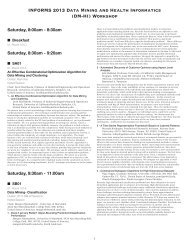
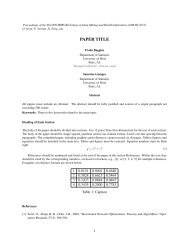
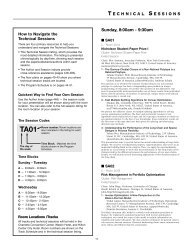
![[PDF] Charlotte Back Matter](https://img.yumpu.com/17933057/1/190x245/pdf-charlotte-back-matter.jpg?quality=85)

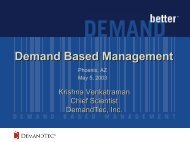
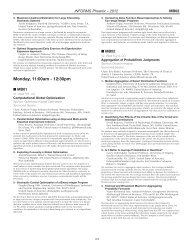
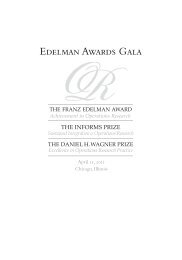
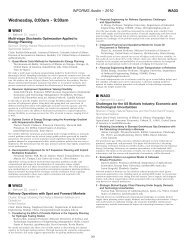
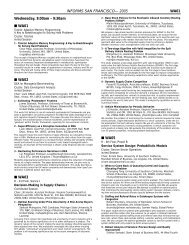
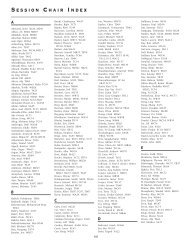
![[PDF] Monday, 8:00am - 9:30am](https://img.yumpu.com/17932954/1/190x245/pdf-monday-800am-930am.jpg?quality=85)
